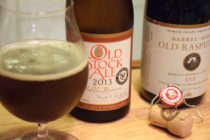Kevin Floyd at The Hay Merchant has always been generous with his beer knowledge, even before The Hay Merchant opened. I took my first beer class from him when he was still at Anvil Bar & Refuge. It was called “Beer 101” and was a great introduction to hops, malts and how beer is made.
There’s a whole lot more to know about craft beer, though, especially when trying to figure out what to buy, what to cellar and how long to cellar it.
Floyd shared so much information with me that I’ve written this as a two-part story. First, we’ll cover what to cellar and how to cellar it. Part 2 will appear in Friday’s My Table SideDish and is called “10 Great Beers for Your Home Cellar.” Whether you’re brand-new to cellaring or are an old pro at it, there are some gems you’re going to want to pick up from the store. Many of Floyd’s recommendations are inexpensive and readily available.
Why Cellar Beer?
Many people are familiar with the idea of storing away wines — who hasn’t seen a movie where a server dramatically presents a bottle of 1968 Château Lafite? These days, beer aficionados pull out bottles of 2010 Real Ale Sisyphus barleywine with just about as much pomp and circumstance.
Floyd explained why you might want to cellar certain styles of beer. “You’re cellaring because it will get better and change with age. The effects of cellaring and time will vary depending on the type of beer. In the case of a bottle-conditioned beer, there is still live yeast or bacteria. By cellaring it, you’re allowing the beer time to develop. It can give some beers time for the high alcohol ‘burn’ to decrease.
“The alcohol content is not going to change, but the flavor melds into the beer. Unfermented sugars, unfiltered yeast cells and undissolved solids will slowly drop out of the beer and the beer will clarify. If a beer has spice, the spice fades over time. When you taste a beer and consider cellaring, it means you want one of these things to happen.”
What NOT to Cellar
“Don’t cellar India Pale Ales (IPAs) at all,” says Floyd. “Hop bitterness is one of the first things to disappear. IPAs should be enjoyed fresh. You’d never cellar spiced beer unless you’re trying to reduce the spice. Saint Arnold Pumpkinator, for example, is a beer I would lay down for only one year. It cuts the spice enough to make it enjoyable to me.”
Also, just because a beer is rare does not mean it should be cellared, Floyd cautioned. “One of the best examples of this was Saint Arnold’s Divine Reserve 7, which was a Weizenbock. Most of the Divine Reserves have been pretty ‘cellarable’ styles and then they did this one, which was not cellarable at all. A lot of people cellared it because they didn’t know any better. Bishop’s Barrel 4 was perfect when it was issued and while it won’t hurt to put it up for a year, it definitely does not need it.”
Another to be aware of is Stone Imperial Russian Stout (IRS). The regular edition is great for aging, but every odd year, Stone Brewing Company issues a special IRS release that is brewed with an additional ingredient. In 2011 it was anise; this past year it was espresso. Floyd recommends not aging these. They are interesting because of their highly volatile ingredients. Aging these beers deadens the very flavors they are prized for.
How Do I Cellar At Home?
Once you’ve obtained beers that you want to age, what’s the right way to do it? I keep all of mine upright in a darkened cabinet, and was happy to find out from Floyd that I’m not damaging my beer collection. “At the very least, you need to store beer in a dark, climate-stable place. It should be no warmer than how you’d keep your house in the summer.”
There’s a better way to store them, however. “If you’re getting into aging beer,” Floyd advises, “I recommend you get a 25- to 30-foot [chest] freezer. You can find them at restaurant supplies stores or you might find one on sale. Then, you can buy a thermostat regulator from a home brew supply store, which is a power interrupter that goes between the freezer plug and the wall. It will turn the power on and off to keep the freezer at 55 degrees. Alternately, you can pay a technician to replace the thermostat in the freezer and convert it into a refrigerator.
Freezers are better insulated than refrigerators (or closets and cabinets), and the compressors tend to be higher quality because they are designed to run at lower temperatures.
Upright Or Lay Them Down?
Many people, including me, are confused on whether to lay beer down or store it upright.
“Beer should always be stored upright,” advises Floyd. “They should never be laid on their sides, with the exception, perhaps, of lambics. You don’t want liquid exposed to the surface of the cap and sediment is going to collect down the length of the bottle. That makes it impossible to pour it without also pouring the sediment.”
In the case of a beer with a cork, though, should we be concerned with the cork drying out? “You don’t need the beer to stay in contact with the cork,” says Floyd. “A cork with a cage or a cap will stay in place. You don’t ever see beer “corked” because it is always carbonated under pressure. There’s not much fear of it “walking.”
The Hay Merchant’s Cellaring Program
Floyd’s beer bar, The Hay Merchant, has a special bottle menu with a small selection of beers that have been cellared. “You can come in here every day and buy a cellared beer. They are, however, priced accordingly. Some are very expensive and rare. Selling the cellar is not my primary business, and prices are a way to separate the people who are just curious and the serious consumer. There is no guarantee on cellared beer. Some of it is several years old and one bottle out of the batch might not be good, so you’re taking a risk.”
As with most things in life, there are rarely great rewards without risks. Beer that has improved with age tastes like a job well done. Intrigued? In the next issue of SideDish, we’ll get you started with Floyd’s list of “10 Great Beers For Your Cellar.”









Follow Us